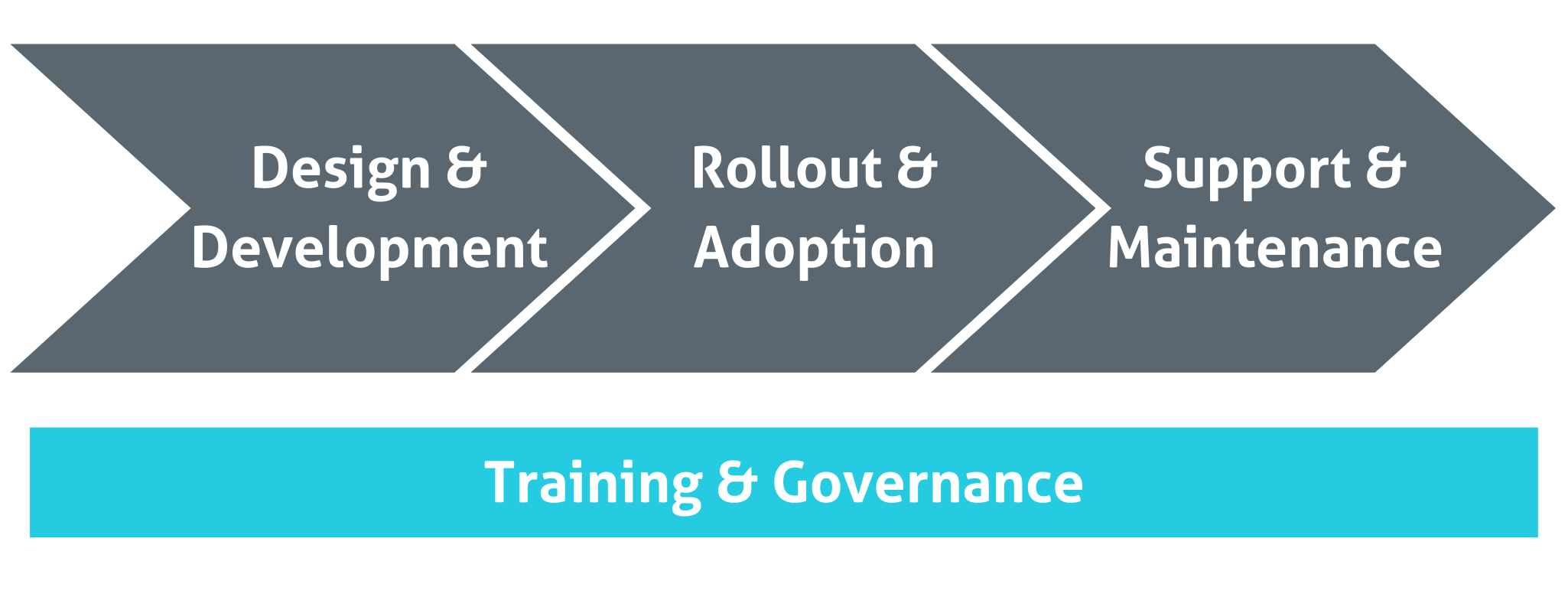by Ian Stuart, Principal Consultant – Altis UK
We have been working with Power BI since it arrived on the market in 2015. Since then we’ve worked with a lot of organisations to help them successfully incorporate Power BI into their daily operations.
We’ve distilled this experience into 3 key steps that are underpinned with Training and Governance:

I am going to discuss the above Altis approach over four blog posts:
- Training & Governance: Types of training required, the importance of training, what should be governed and how
- Design & Development: How to design for maximum impact, the design and development process
- Rollout & Adoption: Introducing Power BI to the wider organisation, monitoring adoption, furthering adoption.
- Support & Maintenance: Ensuring the wheels don’t fall off, helping the end-users, making changes that don’t break other things.
1. Training & Governance
Power BI has provided business intelligence capabilities to a whole new group of excited and eager users. Directors, managers, supervisors and administrators, some with no previous training in data and analytics, are now able to create their own data visualisations and share their work and insights with colleagues and clients.
With excitement, there is sometimes an expectancy that this new tool is going to positively transform the organisation’s data and analytics capability very rapidly. It can certainly help but there is more required than just the tool itself to maximise the potential of data in your organisation and to ensure the correct messages are being communicated through the effective use of Power BI.
Training & Governance provide the foundations of our journey to success.
Training
Many organisations are now viewing Power BI as a core skill. As one of our clients recently put it: “…Power BI is a minimum skill like using Office”.
Training may be used in order to:
- Introduce Power BI to an organisation
- Bring existing report developers to a common level
- Ensure users are following corporate standards and best practice
- Introduce new users to Power BI
- Develop more advanced and complementary skills such as data modelling and data visualisation best practice
- Induct new joiners
- Keep users up to date through refresher workshops and demonstration of latest updates
Most importantly, an appropriately designed training programme will equip staff to make better use of their data to guide and improve decision-making processes.
Without training, people will still use Power BI but probably not as effectively and efficiently as they could after some formal instruction. Worse, they may build misleading and inaccurate dashboards and visualisations through having little or no understanding of data modelling and data visualisation principles or the subtleties of relationships between tables.
Power BI training helps attendees to see what is possible with the tool and understand what other data and analytics components may be needed within their organisation (e.g. a data governance framework). Attendance at training courses can help build data literacy and sow the seeds for increased collaboration in the organisation through establishing, for example; an internal user group, a centre of excellence or an Information Centre.
Altis offers a range of Power BI and related training courses which can all be customised to suit your needs. Find out more about our Altis data & analytics training courses offered in the UK & Western Europe or our range of training courses offered in Australia & New Zealand.
Governance
Without control, it stands to reason that we are out of control. Whilst there are undoubted benefits of allowing people freedom to explore data and create visualisations without constraints, many organisations also recognise that they need to manage a central and “single version of truth”. It is possible to embrace both of these modes of operation within a single organisation:
- Mode 1: Certified datasets, reports and dashboards
- Mode 2: Exploratory analytics, research and innovation
Mode 2 is important to enable the organisation to move with the times or get ahead of the game.
Mode 1 is important to manage the business and monitor performance. Mode 1 operations are not possible without some control. We cannot allow everyone to develop and publish reports, dashboards and datasets without there being an agreed process that ensures the rules of the organisation are not being broken. There need to be rigorous test processes and an agreed deployment mechanism.
Establishing an “Information Centre” that is independent of any particular department, with the remit of ensuring compliance, has proven to be an effective way of governing mode 1. Training may also be required in Data Governance so that the Data Stewards, Data Custodians and others fully understand what is required of them
Power BI allows users to generate powerful interactive data visualisation mechanisms that have the ability to positively transform decision making in an organisation. Effective Training and Governance helps to ensure the validity of data visualisations so we can embark on our journey to success.
In the next blog in this series (Part 2 of 4) I cover Design & Development.
I delivered the following webinar of the same name subsequent to the publication of the blog series. I encourage you to watch it and please feel free to connect with us if you’d like to learn more about how we can help you be successful with Power BI in your organisation.
